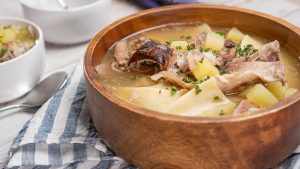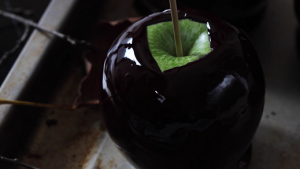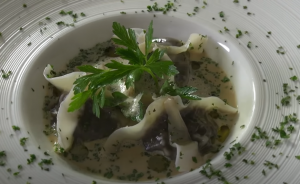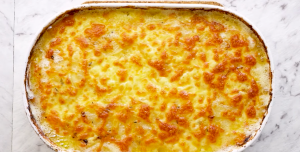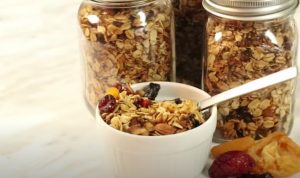Embark on a culinary adventure with this delightful root vegetables with balsamic glaze recipe. This dish combines the earthy flavors of various root vegetables, all beautifully roasted and enriched with a sweet and tangy balsamic glaze. Perfect for a healthy side dish or a hearty vegetarian main, it's sure to become a beloved staple in your kitchen.
While most of the ingredients for this recipe are commonplace, you may need to visit the supermarket for a couple of items. Beets, a key ingredient, are often overlooked but bring a unique sweetness to this dish. Also, balsamic vinegar, which gives a sweet and tangy glaze to the vegetables, might not be a regular pantry staple but is widely available in grocery stores.
Root Vegetables with Balsamic Glaze Ingredients
Beets: Known for their distinct sweet taste and vibrant color. They're full of essential nutrients.
Carrots: A versatile vegetable that adds a sweet and slightly earthy flavor.
Sweet potato: Adds a creamy texture and sweet taste.
Baking potato: Provides a fluffy texture when roasted.
Yukon gold potato: Known for their buttery flavor and golden color.
Garlic: Used for its robust and pungent flavor.
Rosemary: An aromatic herb that adds a fresh, woody flavor.
Olive oil: Helps in roasting and provides a smooth, rich flavor.
Sea salt: Enhances the flavors of the vegetables.
Balsamic vinegar: Adds a sweet and tangy glaze to the vegetables.
One reader, Donnell Montano says:





The root vegetables with balsamic glaze recipe is a game-changer! The combination of earthy beets, sweet carrots, and savory potatoes, all caramelized to perfection with the balsamic glaze, is simply divine. The flavors are rich and the dish is a showstopper. It's a must-try for anyone who loves hearty, flavorful veggies.
Culinary Techniques for Perfecting Root Vegetables with Balsamic Glaze
How to roast the vegetables: Preheat the oven to 450 degrees F (230 degrees C). Mix the beets, carrots, sweet potato, baking potato, Yukon gold potato, garlic, rosemary, olive oil, and sea salt in a 9x13-inch baking dish. Roast the vegetables in the preheated oven for 15 minutes. Remove from the oven, drizzle with balsamic vinegar, and stir. Return to the oven and roast until fork-tender, about 30 minutes more, stirring again after 15 minutes.
How to prepare the balsamic glaze: In a small saucepan, bring the balsamic vinegar to a gentle simmer over medium heat. Cook, stirring occasionally, until the vinegar has reduced by half and is slightly thickened, about 10-15 minutes. Be careful not to overcook it, as it can become too thick and sticky. Once done, remove it from the heat and set it aside to cool slightly before using it on the roasted vegetables.
How To Make Root Vegetables with Balsamic Glaze
A flavourful meld of root vegetables glazed with balsamic vinegar, this recipe is made with vegetables tossed with seasonings and roasted until fork-tender.
Serves:
Ingredients
- 3medium beets,scrubbed and coarsely chopped
- 2medium carrots,peeled and coarsely chopped
- 1large sweet potato,scrubbed and coarsely chopped
- 1medium baking potato,scrubbed and coarsely chopped
- 1medium yukon gold potato,scrubbed and coarsely chopped
- 8garlic cloves,peeled
- 4sprigsfresh rosemary,leaves removed and chopped
- 3tbspolive oil
- 2tspcoarse sea salt
- ¼cupbalsamic vinegar
Instructions
-
Preheat the oven to 450 degrees F.
-
Mix beets, carrots, sweet potato, baking potato, Yukon potato, garlic, rosemary, oil, and sea salt together in a 9×13-inch baking dish.
-
Roast vegetables in the preheated oven for 15 minutes. Remove from the oven, drizzle with balsamic vinegar, and stir.
-
Return to the oven and roast until fork-tender for about 30 minutes more, stirring again after 15 minutes.
Nutrition
- Calories: 183.99kcal
- Fat: 7.16g
- Saturated Fat: 1.07g
- Monounsaturated Fat: 4.98g
- Polyunsaturated Fat: 0.83g
- Carbohydrates: 27.76g
- Fiber: 4.33g
- Sugar: 6.99g
- Protein: 3.17g
- Sodium: 428.18mg
- Calcium: 51.24mg
- Potassium: 637.43mg
- Iron: 1.54mg
- Vitamin A: 367.49µg
- Vitamin C: 14.85mg
Pro Tip: Mastering the Art of Roasting Root Vegetables
When roasting root vegetables, it's important to cut them into similar-sized pieces to ensure even cooking. Larger pieces will take longer to cook, while smaller pieces may burn. Also, tossing the vegetables in olive oil before roasting helps them to cook evenly and gives them a delicious, crispy exterior. The balsamic vinegar added halfway through the cooking process provides a sweet and tangy glaze, but be sure to stir the vegetables well to ensure they're evenly coated.
Time-Saving Tips for Preparing This Recipe
Prep ahead: Chop and store the root vegetables and garlic in an airtight container in the refrigerator the night before to save time on the day of cooking.
Use pre-cut vegetables: Consider using pre-cut root vegetables from the grocery store to save time on prep work.
Multi-task: While the vegetables are roasting, use that time to prepare other parts of the meal or clean up the kitchen to save time overall.
Invest in a good peeler: A sharp and efficient peeler can make quick work of peeling the vegetables, saving you time and effort.
One-pan cooking: Consider using a large roasting pan or sheet pan to cook the vegetables all at once, saving time on cleaning multiple dishes.
Substitute Ingredients For Root Vegetables with Balsamic Glaze Recipe
beets - Substitute with turnips: Turnips have a similar earthy flavor and can be roasted or glazed in the same way as beets.
carrots - Substitute with parsnips: Parsnips have a slightly sweeter and nuttier flavor, making them a great alternative in this recipe.
sweet potato - Substitute with butternut squash: Butternut squash has a similar sweet and nutty flavor and can be roasted and glazed with balsamic vinegar for a delicious alternative.
baking potato - Substitute with rutabaga: Rutabagas have a slightly sweet and peppery flavor and can be roasted and glazed with balsamic vinegar for a unique twist.
yukon gold potato - Substitute with celery root (celeriac): Celery root has a mild, slightly nutty flavor and can be roasted and glazed with balsamic vinegar for a different texture and taste.
balsamic vinegar - Substitute with red wine vinegar: Red wine vinegar can provide a similar tangy and slightly sweet flavor to the dish when reduced and used as a glaze.
Presentation Tips for Serving Roasted Root Vegetables
Elevate the plating: Arrange the roasted root vegetables in a visually appealing manner, ensuring a balance of colors and textures on the plate.
Garnish with fresh herbs: Sprinkle the dish with finely chopped parsley or chives to add a pop of color and a hint of freshness to the dish.
Drizzle balsamic reduction: Create a beautiful design on the plate using a balsamic reduction, adding a touch of acidity and sweetness to complement the earthy flavors of the vegetables.
Use high-quality serving ware: Present the dish on elegant ceramic plates or slate platters to enhance the visual appeal and elevate the dining experience.
Add a touch of edible flowers: Place a few delicate edible flowers such as nasturtiums or pansies on the plate for a sophisticated and artistic touch.
Incorporate microgreens: Sprinkle a small amount of vibrant microgreens over the dish to add a burst of color and a subtle peppery flavor.
Consider the negative space: Utilize the empty space on the plate to create a sense of balance and harmony, allowing the dish to stand out and be the focal point of the presentation.
Essential Kitchen Tools for Making This Recipe
- Oven: An appliance used for baking, roasting, and heating food.
- Baking dish: A dish used for baking and roasting food in the oven.
- Mixing bowl: A bowl used for mixing ingredients together.
- Spatula: A kitchen tool with a broad, flat, blunt blade, used for mixing, spreading, and lifting.
- Measuring spoons: Utensils used to measure small amounts of ingredients.
- Knife: A tool used for cutting and preparing ingredients.
- Cutting board: A durable board on which food is cut and prepared.
- Oven mitts: Protective gloves used when handling hot dishes and cookware from the oven.
- Whisk: A utensil used for whipping and mixing ingredients.
- Basting brush: A brush used for applying sauces and glazes to food.
Storage and Freezing Guidelines for Root Vegetables with Balsamic Glaze
Let the root vegetables cool completely before storing or freezing. This will prevent them from becoming soggy and help maintain their texture.
To store in the refrigerator, place the cooled vegetables in an airtight container. They will keep well for up to 4-5 days.
If you have leftovers that you'd like to freeze for later, follow these steps:
- Transfer the cooled vegetables to a freezer-safe container or resealable bag.
- Remove as much air as possible from the bag or container to prevent freezer burn.
- Label the container with the date and contents for easy identification.
- Place the container or bag in the freezer, where the root vegetables will keep for up to 3 months.
When you're ready to enjoy the frozen vegetables, remove them from the freezer and let them thaw in the refrigerator overnight.
To reheat, place the thawed vegetables in a baking dish and warm them in a preheated oven at 350°F (175°C) for about 15-20 minutes, or until heated through. You can also reheat them in the microwave, stirring occasionally, until they reach the desired temperature.
If you find that the balsamic glaze has become too thick after freezing and reheating, you can thin it out by adding a small amount of water or balsamic vinegar and stirring until it reaches the desired consistency.
The Best Methods for Reheating Leftover Root Vegetables with Balsamic Glaze
Preheat your oven to 350°F (175°C). Place the leftover root vegetables in an oven-safe dish and cover with aluminum foil. Bake for about 15-20 minutes, or until heated through. This method helps retain moisture and prevents the vegetables from drying out.
For a quicker option, use the microwave. Transfer the root vegetables to a microwave-safe dish and cover with a damp paper towel. Microwave on high for 1-2 minutes, stirring halfway through, until heated to your desired temperature. The damp paper towel helps steam the vegetables and prevent them from becoming dry or rubbery.
If you prefer a crispy texture, reheat the root vegetables in a skillet on the stovetop. Add a small amount of olive oil or butter to the pan and heat over medium-high heat. Add the vegetables and stir occasionally until they are heated through and slightly crispy on the edges. This method works well if you want to add extra flavor or crispiness to the dish.
For a flavorful twist, reheat the root vegetables in a cast iron skillet on the grill. Preheat the grill to medium-high heat and place the skillet with the vegetables on the grates. Close the lid and let the vegetables heat through for about 10 minutes, stirring occasionally. This method infuses the vegetables with a smoky, grilled flavor that complements the balsamic glaze.
If you have an air fryer, use it to quickly reheat and crisp up the leftover root vegetables. Preheat the air fryer to 350°F (175°C) and place the vegetables in the basket. Cook for 3-5 minutes, shaking the basket halfway through, until the vegetables are heated and slightly crispy. This method is perfect for achieving a crispy texture without the need for additional oil.
Interesting Trivia About Root Vegetables and Balsamic Glaze
Balsamic vinegar is a popular ingredient in Italian cuisine and is known for its sweet and tangy flavor. It is often used as a glaze or dressing for various dishes, adding a unique depth of flavor to the final dish.
Budget-Friendly: Is This Recipe Economical for Home Cooking?
This root vegetables with balsamic glaze recipe is highly cost-effective for a household. The main ingredients, such as beets, carrots, and potatoes, are affordable and readily available. The addition of balsamic vinegar adds a touch of sophistication without breaking the bank. The total cost for a household of four people is approximately $10, making it a budget-friendly option. The overall verdict for this recipe is 9/10, considering its affordability, nutritional value, and delicious flavors.
Is This Recipe Healthy or Unhealthy?
This root vegetable recipe with balsamic glaze is a nutritious and flavorful dish that offers several health benefits:
- The recipe features a variety of root vegetables, including beets, carrots, sweet potatoes, and regular potatoes, which are all excellent sources of fiber, vitamins, and minerals. These vegetables are rich in antioxidants, such as beta-carotene and vitamin C, which help protect the body from oxidative stress and chronic diseases.
- Garlic, another ingredient in the recipe, is known for its anti-inflammatory and immune-boosting properties, thanks to its high content of allicin and other sulfur compounds.
- Rosemary, a fragrant herb used in the dish, contains rosmarinic acid and other compounds that have antioxidant and anti-inflammatory effects.
- The use of olive oil in the recipe provides healthy monounsaturated fats, which are beneficial for heart health and can help reduce inflammation in the body.
While this recipe is generally healthy, there are a few ways to make it even more nutritious:
- Reduce the amount of salt used in the recipe, as excessive sodium intake can contribute to high blood pressure and other health issues. Instead, try using more herbs and spices to add flavor to the dish.
- Consider using a variety of different colored root vegetables, such as purple potatoes or parsnips, to increase the diversity of nutrients in the dish.
- To boost the protein content of the meal, serve the roasted vegetables alongside a lean protein source, such as grilled chicken or tofu.
- For an extra dose of healthy fats, sprinkle some chopped nuts or seeds, like walnuts or pumpkin seeds, over the finished dish.
Editor's Opinion: Why I Love Root Vegetables with Balsamic Glaze
The root vegetables with balsamic glaze recipe is a delightful combination of earthy flavors and sweet balsamic tang. The use of a variety of root vegetables adds depth to the dish, while the balsamic glaze brings a touch of sweetness and acidity. The roasting process enhances the natural sugars in the vegetables, resulting in a caramelized and tender texture. The addition of garlic and rosemary infuses the dish with aromatic and savory notes. Overall, this recipe is a wonderful way to showcase the natural flavors of root vegetables and is sure to be a hit at any gathering.
Enhance Your Root Vegetables with Balsamic Glaze Recipe with These Unique Side Dishes:
Similar Recipes to Try If You Enjoy Root Vegetables with Balsamic Glaze
Appetizer and Dessert Pairings for Root Vegetables with Balsamic Glaze
Why trust this Root Vegetables with Balsamic Glaze Recipe:
This recipe uses fresh, locally sourced root vegetables and aromatic rosemary. The balsamic vinegar adds a delightful tangy sweetness, enhancing the natural flavors. The combination of beets, carrots, and various potatoes creates a colorful and nutritious dish. The use of garlic infuses a rich, savory taste, while the olive oil ensures a crispy, golden exterior. The careful roasting process allows the vegetables to caramelize, resulting in a delightful medley of textures and flavors. Trust in the simplicity and quality of these ingredients for a delicious and wholesome dish.
Was this page helpful?
Have your own special recipe to share? Submit Your Recipe Today!






